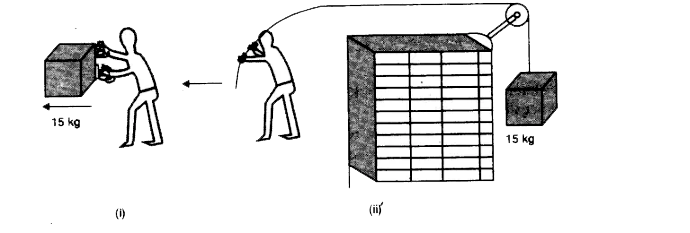Statement-1:Comets move around the sun in elliptical orbits, the gravitational force on the comet due to sun is not normal to the comet's velocity, but the work done by the gravitational force over every complete orbit of the comet is zero.
Statement-2: Gravitational force is a conservative force and the work done by a conservative force over a closed path is always zero.
If both assertion and reason are true and the reason is the correct explanation of the assertion.
If both assertion and reason are true but reason is not the correct explanation of the assertion.
If assertion is true but reason is false.
If the assertion and reason both are false.
The correct Answer is:C
The gravitational force on the comet due to the sun is a conservative force. Since the work done by a conservative force over a closed path is always zero (irrespective of the nature of path), the work done by the gravitational forces over every complete orbit of the comet is zero.
Topper's Solved these Questions
- BOOK - ERRORLESS CHAPTER - WORK , ENERGY , POWER AND COLLISIONEXERCISE - Self Evaluation Test19videos
WORK , ENERGY , POWER AND COLLISION
- BOOK - ERRORLESS CHAPTER - WORK , ENERGY , POWER AND COLLISIONEXERCISE - Graphical Questions28videos
WORK , ENERGY , POWER AND COLLISION
- BOOK - ERRORLESS CHAPTER - WAVES AND SOUNDEXERCISE - SET25videos
WAVES AND SOUND
- BOOK - ERRORLESS CHAPTER - WORK, ENERGY, POWER & COLLISIONEXERCISE - Assertion30videos
WORK, ENERGY, POWER & COLLISION
Similar Questions
Answer the following:
a) The casing of a rocket in flight burns up due to friction. At whose expense is the heat required for burning obtained? The rocket or the atmosphere?
b) Comets move around the sun in highly elliptical orbits. The gravitational force on the comet due to the sun is not normal to the comet's velocity in general. Yet the work done by the gravitatonal force over every complete orbit of the comet is zero. Why?
c) An artificial satellite orbiting the earth in very atmosphere loses its energy grdually due to dissipation against atmospheric resistance, howerver small. Why then does its speed increase progressively as it comes closer and closer tothe earth? d)In fig i) the man walks 2m carrying a mass of 15 kg on his hands. In Fig ii) he walks the same distance pulling the rope behind him. The rope goes over pulley, and a mass of 15 kg hangs at its other end. In which case is the work done greater?
 View Solution
View SolutionAnswer the following:
a) The casing of a rocket in flight burns up due to friction. At whose expense is the heat required for burning obtained? The rocket or the atmosphere?
b) Comets move around the sun in highly elliptical orbits. The gravitational force on the comet due to the sun is not normal to the comet's velocity in general. Yet the work done by the gravitatonal force over every complete orbit of the comet is zero. Why?
c) An artificial satellite orbiting the earth in very atmosphere loses its energy grdually due to dissipation against atmospheric resistance, howerver small. Why then does its speed increase progressively as it comes closer and closer tothe earth? d)In fig i) the man walks 2m carrying a mass of 15 kg on his hands. In Fig ii) he walks the same distance pulling the rope behind him. The rope goes over pulley, and a mass of 15 kg hangs at its other end. In which case is the work done greater?
 View Solution
View Solution
Knowledge Check
- Question 1 - Select One
Statement-1:Comets move around the sun in elliptical orbits, the gravitational force on the comet due to sun is not normal to the comet's velocity, but the work done by the gravitational force over every complete orbit of the comet is zero.
Statement-2: Gravitational force is a conservative force and the work done by a conservative force over a closed path is always zero.AIf both assertion and reason are true and the reason is the correct explanation of the assertion.BIf both assertion and reason are true but reason is not the correct explanation of the assertion.CIf assertion is true but reason is false.DIf the assertion and reason both are false. - Question 2 - Select One
Statement I : Comets revolve round the Sun only in long elliptical orbits
Statement II : A coment develops a tail when it gets close to the SunABoth the statements are individually true and statement II is the correct explanation of statement IBBoth the statement sareindivi dually true but statement II is not the correct explanation of statements ICStatement I is true but statement II is falseDStatement I is false but statement II is true - Question 3 - Select One or More
Consider a planet moving in an elliptical orbit around the Sun. The work done on the planet by the gravitational force of the Sun
Ain some parts of the orbitBin any part of the orbitCin no part of the orbitDin one complete revolution
Work Done By Gravitational Forces
View SolutionIs work done by a non conservative force always negative ? Comment.
View SolutionStatement I : Comets revolve round the Sun only in long elliptical orbits.
Statement II : A comet develops a tail when it gets close to the Sun.View SolutionIs it true for every force in nature that the work done by it on the undergoing motion in a closed loop is always zero?
View SolutionAssertion : The work done by the spring force in a cyclic process is zero.
Reason : Spring force is a conservative force.View Solution

